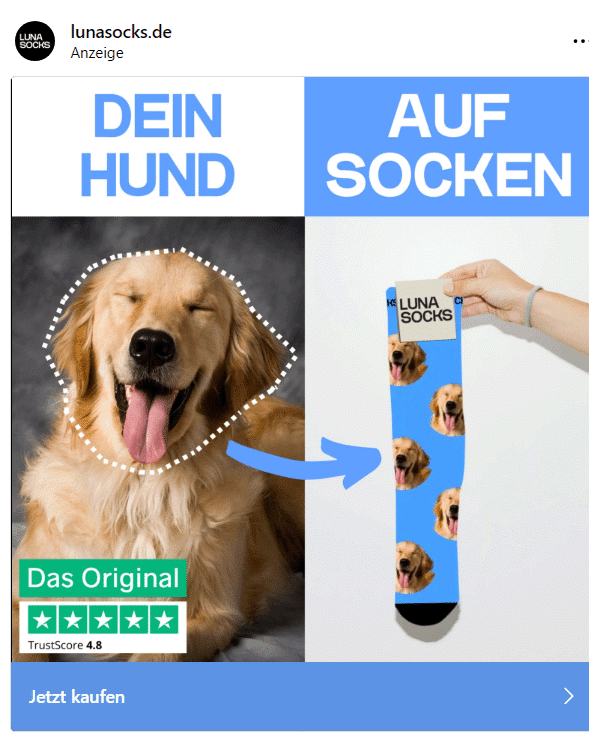
How to Optimize Your Social Media Ad Spend
Did your last Facebook campaign cost a lot of money and yielded little? You don’t know how to use your budget to reach your target group on LinkedIn?
In times of low organic reach, social media ads are a decisive factor in marketing. But every budget is finite. Whether you achieve your goals depends on many details.
In this article, we will show you which measures you can use to make your social ads more effective and get the most out of the money you invest. We give you cross-platform tips and recommendations for specific networks.
Analysis: The starting point for optimization
To make informed decisions and make the best use of your budget, you need a benchmark. You need to know how your ads are performing compared to previous campaigns or industry standards.
Key performance indicators (KPIs) are the be-all and end-all here. The most important KPIs for cost optimization include the following:
- CPV (cost per view): The “cost per view” (CPV) metric measures the cost of a single view of a video on social media platforms. It is primarily used for video ads (e.g. on YouTube, Facebook or Instagram) and provides information about the efficiency of advertising expenditure in relation to the reach of the video. A view is defined as a certain minimum duration.
- CPC (cost per click): The CPC indicates how much you pay for each click on an ad. This value helps you to evaluate the efficiency of a campaign in terms of costs and clicks.
- CTR (click-through rate): The CTR measures the percentage of people who click on your ad after seeing it. It shows how relevant and appealing your ad is to the target group.
- CPM (cost per mille): The CPM indicates the cost per thousand impressions of your ad. It is an important indicator of the reach and visibility of your campaign.
- CPA (cost per acquisition): The CPA measures the cost of a desired action (for example, a purchase or registration). It helps to evaluate the profitability and efficiency of the campaign. You calculate it by dividing the total cost of your campaign by the number of conversions.
Important: The most important key figure is the CPA. This is because most ad campaigns are aimed at conversions. The prerequisite for measuring the CPA is a functioning tracking system.
General optimization strategies for all platforms
Whether Facebook, TikTok or LinkedIn, some optimization tips apply to social media advertising on all platforms:
- Rely on open targeting
In the past, “targeted targeting” and “target group segmentation” would have been at the top of the list. But times have changed.
We now recommend open targeting across all platforms. Open means that you largely refrain from narrowing down target groups when setting up your campaign, for example by selecting interests. Instead, you target all users in a certain age group in a certain region.
The background: The advertising platforms of Meta and Co are now very good at delivering ads in such a way that they achieve the most conversions. In-house targeting can prove to be a disadvantage or even be completely ignored. In addition, social media platforms sometimes have to restrict their tracking for data protection reasons. This means that less data is available for targeting.
Important: The basis for the targeting of Meta and Co are above all the creatives. Therefore, create creatives for all target groups that you want to address.
- Optimize Creatives
Even small changes to ad elements sometimes make a big difference. Make sure you use high-quality, emotive visuals. Emphasize them with concise texts in which you address users directly.

Videos can be very effective, but only if your core message is conveyed in the first 3 seconds. Exceptions prove the rule. A good call to action often provides the decisive push.
Of course, these tips apply not only to social ads, but also to organic content.
- Make targeted use of your budget
Think about how you can use your budget to achieve your goals. Social media platforms give you various bidding strategies to choose from. On Meta, for example, you can set a minimum ROAS (Return on Ads Spend) or maximize conversions by choosing “maximum value”. You can find more information on bidding strategies on Meta in this guide.
Tip: Bidding strategies for social media ads are a complicated topic. Do your research before you enter the ring. It’s worth it.
Do you want to achieve as much reach and interaction as possible with organic content? Then you need to know how the algorithm of each social media platform works. Read our blog article “Social media algorithms and engagement 2024 – how to create viral posts“.
Platform-specific tips for social media advertising
Meta (Facebook, Instagram)
Meta has recently made a number of changes to its advertising options. These reflect the growing importance of artificial intelligence and automation. However, they are also a reaction to data protection regulations.
When optimizing your ad campaigns, consider the following points in particular:
- Flexible ad format
Another new feature is the flexible ad format. If you select it, you can upload up to ten images and videos. Meta then automatically combines these into different ad formats such as single image or carousel and shows users the version they are most likely to respond to.
The catch: this option is currently only available for the campaign goals “Sales” and “App promotion”.
- Add Engagement Custom Audience and Custom Audience
Enter an Engagement Custom Audience (people who have interacted with your brand within the Meta cosmos) and a Custom Audience (people who have performed actions on your website) in the settings of your ad account. This is how Meta automatically carries out retargeting.
- Advantage+ campaigns
The Advantage+ campaigns focus on automatic optimization. This means that the algorithm carries out the targeting independently, distributes the budget automatically and continuously tests and optimizes images and texts. It also adjusts bids in real time.
This significantly reduces the workload for advertisers. As a beginner, you particularly benefit from letting Meta take the wheel. On the other hand, some advanced users are bothered by the lack of control.
- Attribution settings
You can customize the attribution window in the Meta Ads Manager. It defines the period of time after an interaction (click or view) over which a conversion is attributed to your ad. The default option is often “7 days click and 1 day view”. This means that conversions that occur within seven days of a click or one day of a view are attributed to the ad.
The importance of the attribution window setting is often underestimated. However, it has a significant impact on how your reports turn out.
Pay particular attention to the following tips:
- Adapt the window to your product or service. How long do customers usually need to decide to make a purchase?
- Don’t make the window too long. Otherwise too many conversions will be attributed to your ads. This distorts your reports and can make it more difficult to optimize ads.
- With “Compare attribution settings” in the Ads Manager, you can see how different attribution windows affect the reported conversions. This will help you make a decision.
Tips for Instagram ads: It’s difficult to stand out in the flood of high-quality images and videos on Instagram. You have a better chance if you use contrasting colors, for example. Design so that your central message immediately catches the eye and don’t overload your ads.
LinkedIn Ads are a good option if you are doing B2B marketing. But they have one major disadvantage: they are expensive.
That’s why we recommend: As a B2B company, don’t commit to LinkedIn ads straight away. Also test ads on Google and/or Meta. You can often reach the same users on Instagram as on LinkedIn, but at a much lower cost. In addition, the willingness to click is usually higher on Instagram.
If you decide to use LinkedIn Ads, follow these tips:
- Make sure that your ad content is professional, but not boring. Offer users added value, for example by downloading white papers or studies.
You are currently viewing a placeholder content from LinkedIn. To access the actual content, click the button below. Please note that doing so will share data with third-party providers.
More Information- Adapt your content to the area of the funnel in which the target persons are located. For example, attract attention with video ads and provide the decisive impetus for conversion with InMails.
- Manual targeting plays an even greater role on LinkedIn than on many other platforms. Use the possibilities to define and address exact target groups. For a predictive audience, LinkedIn’s AI generates a new target group based on its own data source. This increases the efficiency of ad campaigns.
TikTok
Placing TikTok ads is worthwhile if you are addressing a young target group in social media marketing. Then the video platform is the place to be alongside Instagram. However, TikTok follows its own rules, at least in some places. Get to grips with these before integrating the platform into your marketing strategy.
You can optimize TikTok campaigns as follows, for example:
- Create content in TikTok’s style
Most successful TikTok videos have several of the following characteristics: they are creative and entertaining, get straight to the point, focus on emotions and/or contain a punchline or twist. Authenticity is (much) better than gloss. Nevertheless, your video should be carefully created. All of this also applies to ads. If you’re not quite sure what we’re talking about, it’s time for you to use TikTok more often.
- Use the TikTok Pixel
As on other social media platforms, the pixel is an essential component of campaign tracking on TikTok. However, make sure to use it in compliance with the GDPR.
- Stay up to date
The TikTok community is trend-conscious. You should be too, whether you publish organic content or ads. Keep an eye on what TikTok users are interested in.
Budget planning and scaling strategies
A well thought-out campaign structure is essential to successfully optimize social media ad spend.
- Organize your campaigns according to products or services, target groups and/or campaign goals, for example.
- Create a main campaign with the content that works particularly well and a second campaign to test new approaches and strategies. You can then move what works in the “test campaign” to the main campaign.
- If you want to attract new customers, create a campaign that excludes customers, website visitors and other people who have already interacted with your company.
Only scale ads that are already performing well and increase the budget gradually to maintain efficiency. Regular adjustments and optimization cycles help you to use your budget as efficiently as possible.
Tip: Keep an eye on the time. For example, there are periods of the year when the propensity to buy is high and those when the opposite is true.
Common mistakes in social media advertising and how to avoid them
There are a few mistakes that many social media managers make when creating ad campaigns:
- Overoptimization
While optimization is a crucial factor for the success of social media ads, too much of a good thing can be counterproductive. Many adjustments to ads or the campaign structure at short intervals can mean that the algorithms of social media platforms do not have time to learn from the collected data and optimize the campaign in a stable manner. A common result is unstable performance.
In addition, your social ads may lose relevance due to constant adjustments, resulting in lower visibility and higher costs. An iterative approach with planned optimization cycles, carefully analyzing performance and making well-reasoned adjustments is the key to sustainable success. As a rule, ads perform best in the first few days. If their performance then declines, it makes sense to pause them and put them back online with slight changes after a break.
- Avoid budget traps
One of the most common mistakes when creating social media ads is to spend too much advertising budget on poorly performing ads.
You can avoid this by regularly reviewing campaigns. If an ad is not delivering the desired results, optimize or pause it to avoid wasting your budget unnecessarily. It is usually clear after three days at the latest whether an ad is working or not.
For example, use automated rules in Meta Business Manager for notifications or to automatically pause campaigns if their performance weakens.
Tip: Set a specific amount that you want to pay for a lead, for example. If this figure is still exceeded after 7 days, the sum will usually only increase.
Constant monitoring is crucial for the performance of social media ads
Artificial intelligence opens up new possibilities for social media ads. For example, user experience shows that Advantage+ campaigns on Meta can be very effective with little effort. However, automatic optimizations are not always the ideal solution.
It remains important to set clear goals for ad campaigns on Facebook, LinkedIn and the like, to closely monitor the performance of ads and to make adjustments where necessary. Use your budget in a targeted manner and design eye-catching creatives that stand out from the feed. This way, social media ads become a valuable part of your social media strategy.
Effective ads are important. A powerful control center for your social media marketing is even more important. With Swat.io, you have everything you need for maximum performance: a central inbox, a clear editorial plan for all your channels, monitoring, analytics, AI features for content creation and much more. Try it now for free!
 20. February 2025
20. February 2025 








